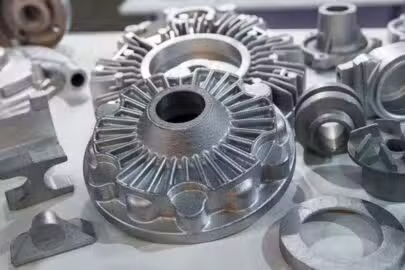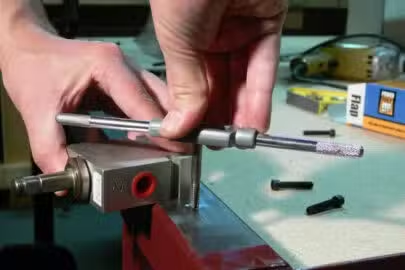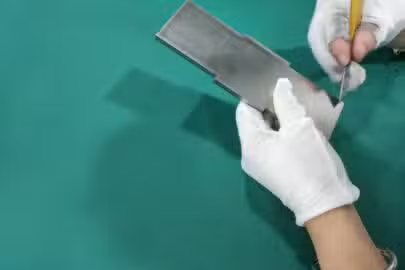Die-casting is a manufacturing method that involves pressuring liquid metal into a mold at high speed and pressure, ranging from 150 to 1,200 bar and speeds of up to 540 km/h. It is a cost-effective way to precisely produce large quantities of intricately shaped, lightweight metal parts. The key distinction between die casting and other casting methods is the high pressure and speed employed in die casting.
Die-casting relies on specialized equipment, and the quality of the final product is closely tied to the equipment’s technical capabilities. It is crucial in industries like automotive, aerospace, and energy.
Understanding and optimizing die-casting costs become imperative for businesses seeking benefits such as high dimensional accuracy, the ability to manufacture complex parts, the use of recyclable materials, and fast productivity in die-casting. This article delves into the cost aspects of die casting, providing insights that can help streamline processes, reduce costs, and enhance efficiency.
What is Die-Casting?
Die-casting, also known as pressure die casting, involves injecting molten metal under high pressure into reusable steel molds (dies). This molten metal is held under pressure during solidification, allowing for the production of intricate shapes due to the high injection pressures employed. This method is widely used in various industries, such as automotive, aerospace, and energy. The process is widely used for complex parts manufacturing and components, especially those with intricate designs and tight tolerances.
Die casting offers advantages such as fast production, the ability to create complex shapes, and the potential for recycling materials. Additionally, the process can be automated for increased efficiency. Die casting is a versatile and widely used method for producing metal parts with excellent precision and detail.
Factors that Influence Die-Casting Cost

Die-casting, renowned for its precision and efficiency, demands a meticulous cost analysis to guarantee economic viability and competitiveness in the current industrial milieu. This detailed examination categorizes various components that contribute to how much does a die casting cost, and the die-casting cost estimators, and they include:
Mold
Initial Tooling Costs
Creating the die-cast mold, the cornerstone of die-casting involves high initial tooling costs. This encompasses the mold’s design, manufacturing, and assembly, which demands precision engineering and careful material selection. The mold’s quality and intricacy directly impact the final product’s precision and complexity. Die-casting machine cost should also include maintenance, to reduce wear and tear.
Ongoing Maintenance
The die-cast mold cost necessitates the inclusion of regular maintenance for optimal performance and longevity. Ongoing expenditures for mold maintenance and refurbishment are critical for sustained efficiency. Proactive maintenance contributes to cost control and minimizes downtime and disruptions in the production process.
Materials
Raw Material Costs
Materials constitute a substantial portion of die-casting costs, involving the expense of the molten metal used in the process. Different metals have varying price points, and factors such as market prices, bulk purchase discounts, and die-casting material efficiency contribute to the overall cost. Strategic material selection is crucial, considering both cost implications and the specific requirements of the manufactured part. Notably, aluminum stands out as a preferred material for die casting, attributing to its superior quality. Also the cost of materials can escalate when they are uncommon or necessitate a specialized process. For instance, the increase in aluminum die-casting cost, as revealed by an aluminum die casting cost calculator, is primarily linked to its compatibility with the cold chamber die casting process. Similar considerations apply to materials like magnesium.
Recyclability Considerations
Material recyclability is a pivotal factor in the contemporary landscape of sustainable manufacturing. Evaluating the feasibility of using recyclable materials in die-casting aligns with environmental goals and has potential cost implications through recycling programs. This dual consideration reflects a commitment to cost-effectiveness and ecological responsibility.
Machines
Energy Consumption
Die-casting machines significantly contribute to energy consumption in the manufacturing process. Assessing and optimizing the energy usage of these machines is crucial for both cost savings and environmental sustainability. Employing advanced melting technologies, optimizing equipment settings, and exploring energy-efficient practices contribute to a more sustainable and cost-effective operation.
Automation Investments
Strategic investments in automation technologies, such as robotics and sensor systems, represent a paradigm shift in die-casting operations. While the initial investment in automation may be substantial, the long-term benefits of reduced labor costs, increased production efficiency, and improved product quality justify the expenditure. Die-casting process automation not only enhances cost-effectiveness but also positions the operation for future competitiveness.
Labor Fees
Skilled Personnel
The skilled workforce required for die-casting operations incurs labor costs, including wages, benefits, and training expenses. Workforce management strategies, training programs, and employee development initiatives impact labor fees and productivity. Investing in skilled personnel contributes to operational efficiency and the quality of the manufactured parts.
Efficiency and Productivity
Optimizing labor resources through efficient workforce management is crucial for controlling labor costs. Employee training programs focused on operational efficiency, safety, and skill development minimize errors and contribute to overall production output. Balancing labor fees with fast productivity in die-casting ensures a competitive edge in manufacturing.
Others
Scrap and Waste Management
Effective waste management is integral to sustainable and cost-effective die-casting operations. Assessing the amount of material wastage or scrap generated during the process is essential. Strategies such as optimizing gating systems, recycling scrap materials, and adopting lean manufacturing principles contribute to cost savings and align with environmental sustainability goals.
Quality Control Measures
Investing in quality control measures is a fundamental aspect of die-casting cost analysis. Costs associated with inspection processes, testing equipment, and personnel training for quality assurance must be considered. Robust quality control minimizes defects, reduces rework costs, and ensures compliance with industry standards, ultimately contributing to customer satisfaction and long-term business success.
Transportation and Logistics
Transportation and logistics costs are critical considerations for facilities relying on external suppliers for raw materials or distributing finished products. Analyzing shipping rates, exploring logistics optimizations, and ensuring timely deliveries contribute to cost-effective operations. Strategic management of transportation costs enhances overall efficiency and customer satisfaction.
Environmental Compliance
In an era where environmental sustainability is paramount, die-casting cost analysis must include considerations for environmental compliance. Adhering to regulations related to waste disposal, emissions control, and other environmental impact factors is imperative. Investments in eco-friendly practices may involve initial costs but can lead to long-term benefits through regulatory compliance, enhanced corporate responsibility, and a positive brand image.
How to Optimize the Die-casting Fees

Achieving a low cost die-casting involves finding ways to improve efficiency, reduce waste, and enhance the overall cost-effectiveness of the die-casting process automation. Here are some strategies to consider to optimize your die-casting cost:
Design Optimization
Efficient design optimization is paramount for ensuring cost-effective die casting. A seamless collaboration between design and manufacturing teams is essential to guarantee that the parts meet functional requirements and facilitate efficient production processes. Integrating design for manufacturability (DFM) principles becomes crucial in streamlining manufacturing. This entails simplifying complex geometries, reducing intricate features, and ensuring designs align with the die-casting process.
Simulation tools are pivotal in predicting a part’s behavior during the die-casting process. This foresight allows for adjustments before actual tooling and production, averting costly iterations and rework. Drafting angles, wall thickness, and core placement significantly impact tooling costs and die-casting cycle times.
Material Selection
Choosing the appropriate material is a critical decision in die casting. The evaluation process should consider mechanical properties, thermal conductivity, and cost. Striking a balance between material performance and affordability is essential. Collaborating with material suppliers is critical to exploring options and negotiating bulk purchase pricing.
Consideration of alternative materials is prudent. Sometimes, a material with similar properties but lower costs may offer a viable alternative. However, ensuring that the chosen material meets all necessary performance criteria, including strength, durability, and corrosion resistance, is imperative.
Tooling and Mold Design
Investing in high-quality tooling and molds is an upfront cost that yields long-term benefits. Durable tooling extends mold lifespan and reduces the frequency of replacements, minimizing downtime and associated costs. When designing molds, the emphasis should be on simplicity and efficiency. Complex molds with intricate features can escalate production costs and lead to longer cycle times.
Using multi-cavity molds is a strategic move to increase production output without a proportionate cost increase. Although the initial investment may be higher for multi-cavity molds, the cost per unit tends to decrease, making it a cost-effective choice for larger production runs.
Production Volume
Increasing die-casting production volume is a central strategy for achieving economies of scale. Larger production runs generally result in lower per-unit costs. However, meticulous planning and efficient production schedule management are critical to avoiding unnecessary downtime and ensuring equipment utilization efficiency.
Implementing a robust demand forecasting system helps anticipate production needs, enabling better planning and preventing overproduction or underproduction scenarios. Maximizing equipment utilization and minimizing idle time enhance overall production efficiency.
Automation
Automation is a pivotal element in optimizing die-casting processes. While the initial investment in automation technology can be substantial, the long-term benefits often outweigh the costs. Automated systems proficiently handle tasks such as material handling, part removal, and quality control, reducing labor costs and enhancing consistency in production.
A phased approach to automation implementation, starting with high-impact areas, is advisable. Automating repetitive and time-consuming tasks allows human resources to focus on more complex and value-added activities. Regular assessments and updates to automation systems ensure they incorporate the latest technologies and improvements.
Process Monitoring and Control
Robust process monitoring and control systems are indispensable for maintaining high-quality production and minimizing costs associated with defects and rework. Implementing sensors and feedback mechanisms that provide real-time data on critical process parameters allows immediate intervention if deviations from the desired conditions are detected.
Regular maintenance and calibration of equipment ensure consistent performance. Instituting preventive maintenance schedules addresses potential issues before they result in downtime. Continuous improvement initiatives should focus on refining process monitoring and control systems based on lessons learned from previous production cycles.
Energy Efficiency
Energy costs significantly contribute to overall production expenses. Thus, optimizing energy efficiency is both environmentally responsible and economically beneficial. Conducting an energy audit identifies areas where energy consumption can be reduced.
Optimizing machine settings minimizes energy usage during production. Upgrading energy-efficient equipment that meets the exact production requirements but consumes less power is prudent. Implementing technologies such as regenerative braking on machines to recover and reuse energy, alongside exploring alternative energy sources like solar or wind, further reduces energy costs and environmental impact.
Supplier Relationships
Establishing strong relationships with material suppliers is crucial for obtaining favorable pricing and ensuring a reliable supply chain. Close collaboration with suppliers to understand market trends, negotiate bulk pricing, and explore opportunities for cost savings is vital.
Long-term partnerships with suppliers can be mutually beneficial. Suppliers may offer valuable insights into material alternatives or suggest improvements in the production process. Regular communication and collaboration can result in joint initiatives to reduce costs and improve efficiency.
Waste Reduction
Minimizing material waste is both environmentally responsible and contributes to cost savings. Implementing lean manufacturing principles identifies and eliminates unnecessary steps in the production process. Optimizing the die-casting process automation to reduce the amount of scrap material generated is crucial.
Implementing recycling programs for scrap materials reduces waste and provides cost savings, as recyclable material in die-casting can sometimes be used in the production process. Additionally, waste reduction initiatives enhance the manufacturing operation’s overall sustainability profile.
Continuous Improvement
Fostering a culture of continuous improvement is fundamental for long-term success in die-casting. Encouraging employees at all levels to actively participate in identifying and suggesting improvements to the production process is crucial. Regular review cycles are also necessary to assess the effectiveness of implemented changes.
Embracing feedback from the production team, who often have valuable insights into day-to-day operational challenges, is essential. Staying informed about advancements in die-casting technology and industry best practices ensures processes are regularly updated based on lessons learned, technological advances, and changes in market conditions.
This table provides a structured overview of key strategies that manufacturers can employ to reduce costs in the die casting process.
| Cost Reduction Strategy | Description |
| Process Optimization | Implement efficiency improvements in the die-casting process, reducing die-casting cycle times and increasing throughput.- Invest in technology upgrades to enhance automation and precision, minimize errors, and improve production efficiency. |
| Supply Chain Management | – Negotiate with suppliers for bulk purchasing or favorable terms, reducing the cost of raw materials and components.- Adopt just-in-time inventory practices to minimize carrying costs and reduce the need for large storage spaces. |
| Continuous Improvement | – Establish a culture of continuous improvement, encouraging employees to identify and implement cost-saving ideas.- Regularly review and update processes based on performance metrics and industry best practices. |
| Quality Control Measures | – Implement rigorous quality control protocols to minimize defects and rework, reducing the overall cost of producing high-quality components.- Invest in inspection technologies and training programs to ensure consistent product quality and minimize the need for post-production corrections. |
| Energy Efficiency Initiatives | – Implement sustainable practices to reduce energy consumption and costs.- Explore alternative energy sources, such as renewable energy, to power die-casting operations and decrease dependence on traditional, potentially costlier, energy sources. |
| Lean Manufacturing Practices | – Adopt lean manufacturing principles to eliminate waste, optimize processes, and reduce unnecessary costs.- Streamline production workflows to minimize idle time, overproduction, and unnecessary handling of materials. |
| Supplier Relationship Management | – Build strong relationships with key suppliers to negotiate better prices, terms, and delivery schedules.- Collaborate with suppliers to identify cost-saving opportunities and explore joint initiatives for continuous improvement. |
| Training and Skill Development | – Invest in training programs to enhance the skills of the workforce, improving efficiency and reducing errors.- Cross-train employees to create a flexible workforce that can adapt to changing production needs without the need for additional hiring. |
| Waste Reduction and Recycling | – Implement waste reduction strategies to minimize material scrap and waste.- Introduce recycling programs to reclaim and reuse materials, reducing both disposal costs and environmental impact. |
| Technology and Innovation | – Stay abreast of technological advancements in die-casting equipment and processes, adopting innovations that enhance efficiency and reduce costs.- Invest in research and development to explore new materials or techniques that may save costs. |
Conclusion
Die casting costs are a complex amalgamation of various factors shaping the financial aspect of this manufacturing method. Initial investments in tooling and dies and fluctuating raw material costs form the core expenses. Skilled labor, energy-intensive machine operations, and maintenance add significant operational costs.
To navigate this landscape successfully, businesses must strategically optimize factors for efficiency and cost-effectiveness, leveraging economies of scale and adopting innovative solutions. A nuanced understanding of the diverse elements influencing die-casting costs is crucial for manufacturers aiming to maintain competitiveness in the evolving manufacturing sector. If you have any questions regarding the die-casting process or seek guidance on optimization, you can contact our team of experts at Zintilon.
FAQs
What is die-casting?
Die-casting is a metal casting process that involves forcing molten metal into a mold cavity under high pressure. This process is widely used for producing accurately dimensioned, sharply defined, smooth, or textured-surface metal parts.
What factors contribute to die-casting costs?
Die-casting costs are influenced by various factors such as material selection, tooling and mold design, production volume, and energy efficiency. Labor costs, automation investments, and maintenance also play pivotal roles.
Why is cost analysis important in die-casting?
Cost analysis in die-casting helps manufacturers understand and manage the expenses associated with the process. It includes material costs, labor costs, equipment costs, and overhead fees. Analyzing these die-casting cost estimators is crucial for optimizing production efficiency and competitiveness.





